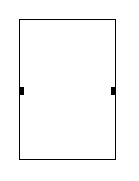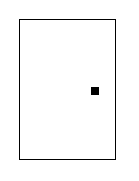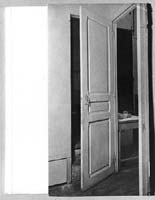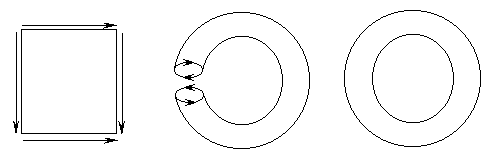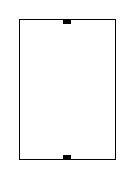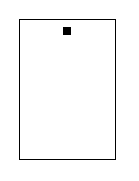|
4a. Recipe for Bottles We read, in the
Green Box, the note:
Although the note is a little bit obscure, and as always it's reading is arduous, it is possible to hypothesize an interpretative model consistent with its principal parts; furthermore, this model is consistent with some of Duchamp's capital works. Let's start by
imagining a simple rectangle. If we trace a vertical axis across this
rectangle, it makes sense to distinguish right and left parts of the
figure with respect to that axis. Now, if we are in a 3D space, with
a circular motion we close the rectangle to form a cylinder (Fig.
33A).
It no longer makes sense to speak about right and left parts with respect to the previous axis, because each point of the cylinder can be reached by turning toward either the left or the right. If we use the
rectangle to represent the cylinder in a 2D space, we must agree upon
the simple convention that the two vertical sides of the rectangle represent
the same line of the cylinder. Thus, if we walked on the rectangle as
if we were on the cylinder, when we went out from the left side we could
continue re-entering from the right side, and vice versa, as
shown in Fig. 33B and
33C.
Duchamp applies this idea to the suggestive Door: II, rue Larrey (1927) (Fig. 34): when the door closed the left room, it opened the right one, and vice versa. Thus, by means of a simple circular closing we pass from the rectangle to the cylinder, losing the distinction between left and right. Now, if we repeat the same operation of circular closing starting from the cylinder, we obtain a ring-shaped figure which topologists call torus or tore (Fig. 35A). With this operation we lose the distinction between high and low too.
As before, if
we use the rectangle to represent the torus in a 2D space, we must agree
upon a second simple convention, analogous to the first one: the two
horizontal sides of the rectangle represent the same circular line along
the torus, and if we walked on the rectangle as if we were on the torus,
when we went out from the top side we could continue re-entering from
the bottom side, and vice versa, as shown in Figs.
35B and 35C.
>>Next
Fig.
34
page 1 2 3 4 5 6 7 8 9 10 11 12 13 14 15 |

